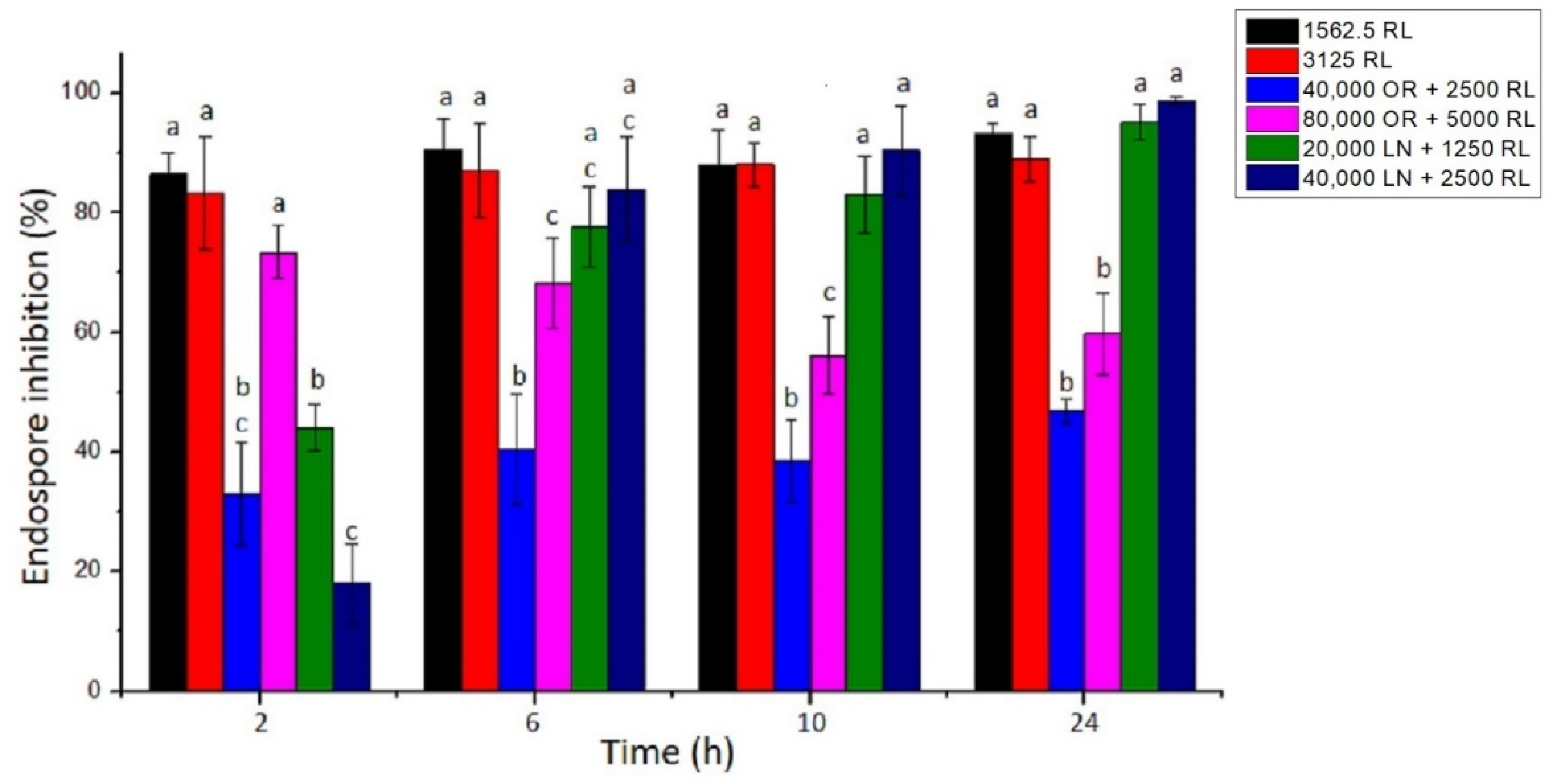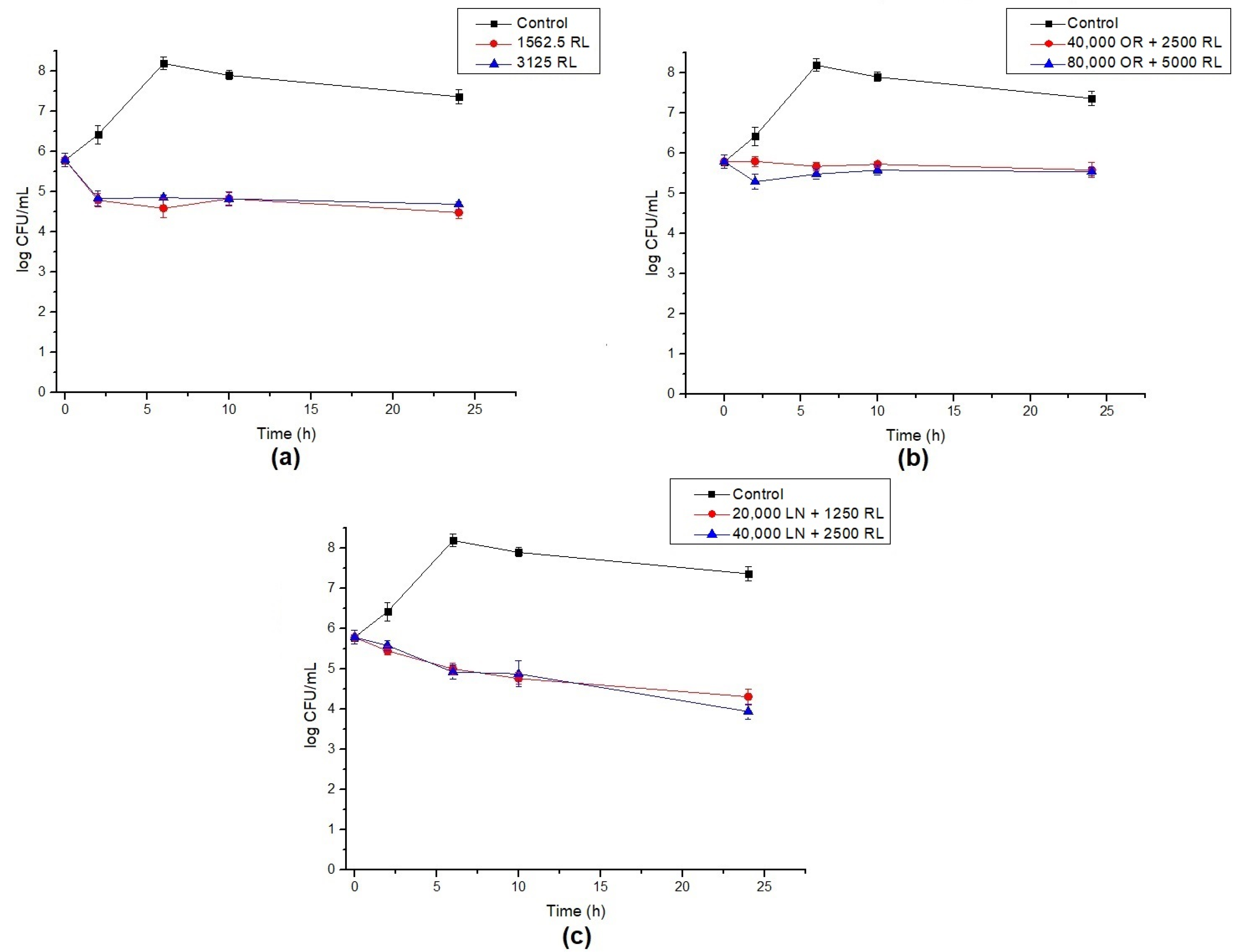Correction: Bertuso et al. Combining Celery Oleoresin, Limonene, and Rhamnolipid as a New Strategy to Control Endospore-Forming Bacillus cereus. Foods 2021, 10, 455
Text Correction
2.2. Mixture Stock Solutions
3.2. Minimal Inhibitory Concentration (MIC) and Minimal Bactericidal Concentration (MBC)
Error in Figures/Table
Reference
- Bertuso, P.C.; Mayer, D.M.D.; Nitschke, M. Combining Celery Oleoresin, Limonene and Rhamnolipid as New Strategy to Control Endospore-Forming Bacillus cereus. Foods 2021, 10, 455. [Google Scholar] [CrossRef] [PubMed]



| Compound | MIC (μg/mL) | MBC 24 h (μg/mL) | MBC 48 h (μg/mL) |
|---|---|---|---|
| RL | 98 | 1562.5 | 1562.5 |
| OR | 40,000 | >40,000 | >40,000 |
| OR + RL | 2500 OR + 156.3 RL | 20,000 OR + 1250 RL | >40,000 OR + 2500 RL |
| LN | 2500 | >40,000 | >40,000 |
| LN + RL | 1250 LN + 78.1 RL | 20,000 LN + 1250 RL | 20,000 LN + 1250 RL |
| Compound | MIC (μg/mL) | MBC 24 h (μg/mL) | MBC 48 h (μg/mL) |
|---|---|---|---|
| RL | 98 | 1562.5 | 1562.5 |
| OR | 40,000 | >40,000 | >40,000 |
| OR + RL | 2500 OR + 156.3 RL | 20,000 OR + 1250 RL | >40,000 OR + 2500 RL |
| LN | 2500 | >40,000 | >40,000 |
| LN + RL | 1250 LN + 78.1 RL | 20,000 LN + 1250 RL | 20,000 LN + 1250 RL |
Disclaimer/Publisher’s Note: The statements, opinions and data contained in all publications are solely those of the individual author(s) and contributor(s) and not of MDPI and/or the editor(s). MDPI and/or the editor(s) disclaim responsibility for any injury to people or property resulting from any ideas, methods, instructions or products referred to in the content. |
© 2023 by the authors. Licensee MDPI, Basel, Switzerland. This article is an open access article distributed under the terms and conditions of the Creative Commons Attribution (CC BY) license (https://creativecommons.org/licenses/by/4.0/).
Share and Cite
Bertuso, P.d.C.; Mayer, D.M.D.; Nitschke, M. Correction: Bertuso et al. Combining Celery Oleoresin, Limonene, and Rhamnolipid as a New Strategy to Control Endospore-Forming Bacillus cereus. Foods 2021, 10, 455. Foods 2023, 12, 645. https://doi.org/10.3390/foods12030645
Bertuso PdC, Mayer DMD, Nitschke M. Correction: Bertuso et al. Combining Celery Oleoresin, Limonene, and Rhamnolipid as a New Strategy to Control Endospore-Forming Bacillus cereus. Foods 2021, 10, 455. Foods. 2023; 12(3):645. https://doi.org/10.3390/foods12030645
Chicago/Turabian StyleBertuso, Paula de Camargo, Débora M. Drappé Mayer, and Marcia Nitschke. 2023. "Correction: Bertuso et al. Combining Celery Oleoresin, Limonene, and Rhamnolipid as a New Strategy to Control Endospore-Forming Bacillus cereus. Foods 2021, 10, 455" Foods 12, no. 3: 645. https://doi.org/10.3390/foods12030645
APA StyleBertuso, P. d. C., Mayer, D. M. D., & Nitschke, M. (2023). Correction: Bertuso et al. Combining Celery Oleoresin, Limonene, and Rhamnolipid as a New Strategy to Control Endospore-Forming Bacillus cereus. Foods 2021, 10, 455. Foods, 12(3), 645. https://doi.org/10.3390/foods12030645







